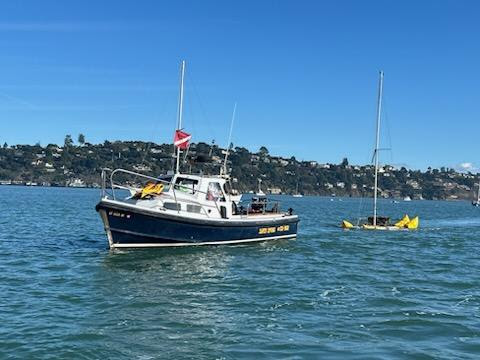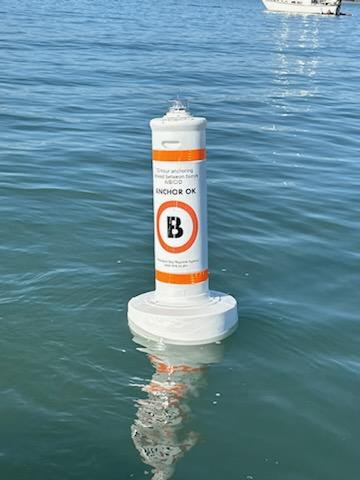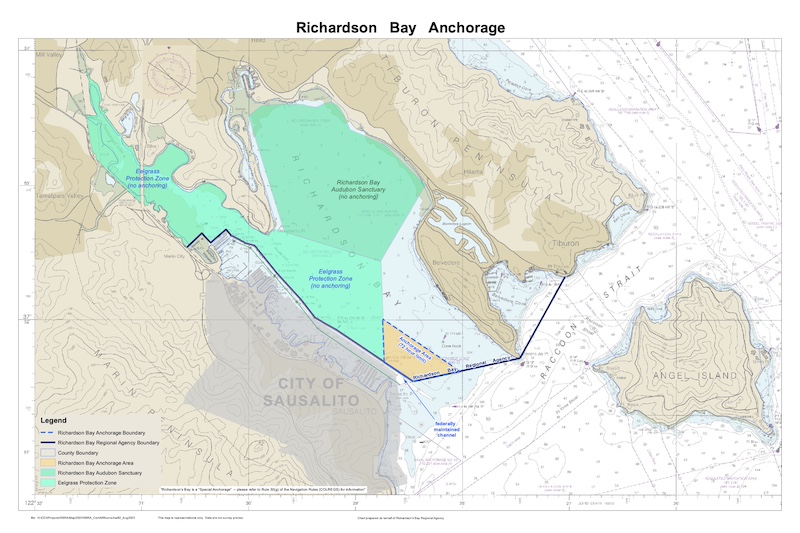
- General Sailing
- Current News
- Maritime History
- Environmental News
- Safety
- West Coast Sailing
- Working Waterfront
Anchor-Outs’ Last Days In Richardson Bay
Local sailor and friend of Latitude John “Woody” Skoriak happened to be in Sausalito and bumped into Dave Gissendaner (Diver Dave) of Dave’s Diving Services. Woody tells us Dave’s divers and the crew from Parker Diving Service have been removing, and towing to a temporary anchorage, the last of Richardson Bay’s anchor-out boats. Below, Woody shares an update of the situation.

Sausalito boaters may have noticed a lot of activity in the Richardson Bay Anchorage. Local diving and salvage operations like Dave’s Diving Services and Parker Diving Service have been clearing out sunken boats, and towing away abandoned and unsafe craft to the US Army Corps of Engineers. Diver Dave Gissendaner said the demolition crews have been so busy, the situation was “take a number and get in line.”
The goal is to clear the anchorage of unsafe and unsanitary vessels and return it to the status that Richardson Bay has always had, but that was never enforced — a Special Federal Anchorage where vessels can anchor only 72 hours maximum. Richardson Bay was declared a Special Federal Anchorage in 1969. This enforcement will help clean Richardson Bay of unsafe (and often unregistered) craft, and at the same time protect the Bay’s eelgrass, which local ecosystems depend on.
The Richardson Bay Regional Authority (RBRA) has placed new buoys marking the Special Anchorage and will move the few dozen boats left to an alternate anchorage outside Richardson Bay. According to Gissendaner, this is meant to be just a “holding pen” until the owners of the boats can also be relocated to shoreside housing.


All the local city, county, state and federal agencies are working to make this happen, and the target date is October 2026. But in the meantime, Gissendaner says that all agencies and authorities intend to regulate and enforce the Special Federal Anchorage. That’s news that most boat owners, marinas and maritime enterprises in Sausalito and around the Bay will undoubtedly welcome. ”

wow, it looks like they designated 2/3 of the useable anchorage area as “Eelgrass Protection Zone.”
That is certainly a policy decision.
Pretty soon nobody will be able to anchor anywhere, the whole bay and coast will be designated as an Eel Grass Protection Zone. The government got rid of Drake’s Bay Oyster Farm because they said the farm was harming the eel grass. I wonder how much money it is costing tax payers to set up these liveaboards in permanent housing in Sausalito? Yes, the idea of all those people flushing their human waste directly into the Bay is repulsive, but a better (and cheaper) solution would have been to send a boat out there and offer pump out services and remove abandoned boats. It’s a bit silly that in a middle of a homeless crisis and housing crisis we prohibit 90% of boat owners in California from living on their boat. I’m sure most boat owners (me included) don’t want vagabonds filling up all the marinas or every anchorage in the bay, but I think we would all, if given a choice, would rather follow Norwegian sailor Jarle Andhoy’s motto of “born free, live free” than live under the calloused thumb of the Government. I think boaters, sailors, and liveaboards should have had a bit more solidarity on this issue rather than submitting this part of the Bay, and maybe in the future all parts of the Bay, to the eel grass.
@Ryan:
Nice red herring you got there. Eel grass is one thing, but let’s talk about the inevitable consequences of these un-seaworthy, derelict “vessels” that either wash ashore, or sink and become hazards to navigation, leak fluids, etc: Who pays for the remediation then? And why should others pay for house calls on their sanitary needs? What if they don’t have functioning holding tanks? Is someone going to pay to pay to install that for them?
Re liveaboards in general, marina space is at a premium already, and I believe should be highly prioritized for “Sailors”, not as overflow living units. There are millions of housing units in the bay area, but only a tiny fraction of that in slips for actual boaters who use their boat on the water, and not as a tent.
Abandoned vessels in Richardson Bay should be removed before they sink, no argument there. If it’s not abandoned it shouldn’t be removed IMHO. I assume the majority of people that anchor out don’t have insurance so if it sinks while they are living aboard they should be charged for the remediation costs and if they can’t afford it which I am guessing most can’t, they’ll need to declare bankruptcy, as is the American way. Regarding the idea about the pump out boat servicing them, like I said, that would be a more cost effective way of eliminating some of the issues with them living out there compared to the $3.3 million spent on housing them for the next three years which I guess will continue on indefinitely or many of them will be living on the street which might happen to some of them eventually anyway. Personally, I think swimming in Richardson Bay is way cleaner than swimming in Ayala Cove with all that seal pop and the government seems to be promoting the little seal colony there over the tax payers that paid for those boat docks and the heath of visitors that swim at that beach. It is disgusting thought, but in reality Richardson Bay gets flushed out pretty well from what I can tell, so it doesn’t matter much to me, as I happily swim in Richardson Bay as does my kid. It was just an economical suggestion rather than forcing someone to leave their boat and paying for their housing (and food?) indefinitely. I also agree that marinas should be used by sailors, but I’m guessing that anchor outs are more sailor-like than most of the people that own boats in most marinas in the Bay. There are almost a half dozen boats on my dock alone that have not moved for what must be a decade and about a dozen that might go out once a year, if that. I admit, when I was looking for a slip I purposely chose one with no immediate liveaboards next to me, but at the same time if I want to sleep in my boat more than three nights per week, I feel that I should have that right. It’s my property. Why is the government telling me when I can and can’t sleep on my property? In my ideal world, I would have a catamaran in SoCal that I could stay at for a couple weeks at a time and travel back and forth, especially during the cold Bay Area winters and I think it is BS that I would need to sign up for a 20 year long wait-list because of some government regulation that doesn’t make much sense other than keeping “undesirables” from filling up marinas. If we’re making rules about who can and can not use slips, maybe a better rule is that if you rent or buy a slip you must use your boat at least twice a year. Then there will be plenty of room in marinas, half the boats would be gone…Marina space wouldn’t be a premium then…